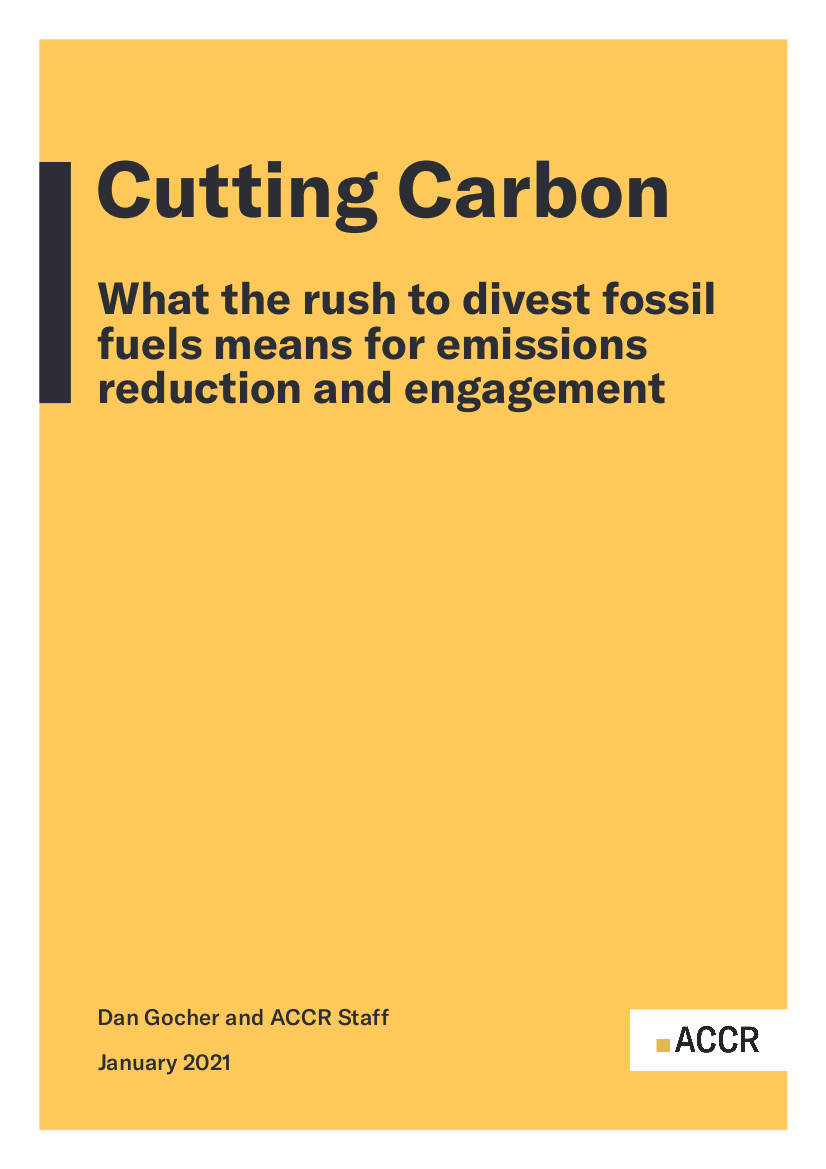Publication Cutting Carbon: What the rush to divest fossil fuels means for emissions reduction and engagement: 3. Why climate matters to investors
Institutional investors are becoming increasingly attuned to the serious risks posed by climate change. The classification of these risks varies somewhat between analyses.[1] Most separate out the most straightforward and easy to grasp category: physical risks to assets from climate change. In the context of increasingly frequent and severe extreme weather events, even non-specialist investors are becoming aware of the highly visible risks to investments across a variety of sectors. Insurers face soaring costs of payouts in the wake of hurricanes; electricity providers are being forced to replace swathes of power lines destroyed by bushfire; real estate asset owners are being hit with lengthy rebuilding periods where they cannot receive rental income.[2] Investors are increasingly looking to companies to account for the material risks of climate change to physical assets, operations and, ultimately, returns.
The second group of risks arises from a more complex series of factors, which are particularly acute for investors in heavy emitting companies. The first is transition risk: that sudden, dramatic and/or uneven shifts away from fossil fuelled economic activity will render particular assets—and sometimes whole companies and sectors—dramatically less profitable. The potential for assets to become “stranded” in a zero-carbon future is a topic of deep concern for investors,[3] who look also to risks posed by fast-developing regulatory and policy change, under both national legislative regimes and international agreements. Activity in this arena intensified in 2020, with several national governments making commitments to net-zero emissions, exploring options for intervention such as carbon tariffs, and the US president-elect promising the country’s return to the Paris Agreement.
The Principles for Responsible Investment’s Inevitable Policy Response (IPR) forecasts “a response by 2025 that will be forceful, abrupt, and disorderly”[4] because of the delays to date in responding to climate change. The IPR suggests that it is no longer a matter of if governments take action, but when they take action. Any large scale government intervention to address carbon emissions is likely to have a significant impact on companies that are yet to commit to ambitious emissions reduction pathways.
Emissions-intensive industries also face increasing reputational risk, as companies receive heavier public scrutiny and criticism.[5] Though the COVID-19 pandemic has changed the landscape of public advocacy, public concern around climate change has not receded. Heavy emitters face continual pressure, particularly in the context of proposals for large government bailouts and stimulus packages.
Finally, the threat to portfolio returns from ‘systemic risk’—system-wide macroeconomic damage resulting from climate change and related upheaval—is becoming more widely recognised.[6] Australian regulators have acknowledged as much,[7] pushing companies to adopt more rigorous disclosure of their exposure to various eventualities. Recent studies have foreshadowed widespread future negative economic impacts in Australia of a failure to act decisively on climate change: the Australia Institute estimated the potential cost at $131 billion dollars per year,[8] while Deloitte Access Economics estimated a total of $3.4 trillion in GDP losses by 2070.[9]
The growing salience of these risks has impelled investors to explore opportunities to drive emissions reductions, resulting in the proliferation of investor climate networks including the Ceres Investor Network, Climate Action 100+, The Investor Agenda, Climate League 2030, the Global Investor Coalition on Climate Change, the Investor Group on Climate Change (IGCC), the Institutional Investors Group on Climate Change (IIGCC), and the UN-convened Net-zero Asset Owner Alliance (recent consultations by the latter two will be examined in more detail below). In the last month of 2020, two new initiatives were announced: the Net Zero Asset Managers Initiative and the Net Zero Underwriters Alliance.
International Finance Corporation, “Account for Climate Risk” (website), accessed 27 November 2020; World Resources Institute and Ceres, “Questions and Answers for Investors on Climate Risk”, Investor Network on Climate Risk Research Consortium, December 2004; https://www.fsb-tcfd.org/about/, accessed 27 November 2020. ↩︎
Ausnet Services, “Ausnet Annual Report 2020”, May 2020; IBISWorld, “2019-20 Australian Bushfire Crisis: The Economic Impact”, March 2020. ↩︎
Carbon Tracker, “Unburnable Carbon: Australia’s Carbon Bubble”, December 2013. ↩︎
https://www.unpri.org/inevitable-policy-response/what-is-the-inevitable-policy-response/4787.article, accessed 23 December 2020. ↩︎
EY, “Climate Change: The Investment Perspective”, 2016. ↩︎
Commissioner Rostin Behnam and Bob Litterman, “Managing Climate Risk in the U.S. Financial System”, n.d., p196; Barnali Choudhury, “Climate Change as Systemic Risk”, SSRN Scholarly Paper (Rochester, NY: Social Science Research Network, October 2020); Veena Ramani, “Addressing Climate as a Systemic Risk: A Call to Action for Financial Regulators”, The Harvard Law School Forum on Corporate Governance (blog), June 2020; Teresa Johnson, “Treat Climate Change as a Systemic Risk to Global Finance”, Financial Times, March 2020. ↩︎
James Fernyhough, “ASIC Names Climate Change ‘Systemic Risk’ in Rulebook”, Australian Financial Review, August 2019. ↩︎
Tom Swann et al., “Cold Shower on Economics of Global Warming”, The Australia Institute, April 2019, p1. ↩︎
Deloitte Access Economics, “A New Choice: Australia’s Climate for Growth”, November 2020, p5. ↩︎
